Weddings in Poland are all about bringing people together for a big, hearty feast! When Poles celebrate marriages, they go all out with tons of delicious food that can feed many hungry guests. Newlyweds and their loved ones happily feed the guests over hours of celebrations. It’s their way of showing generosity, love, and best wishes for the couple starting a new life together.
It’s no secret that the main event at a Polish wedding is quite often the food. The star dishes are usually hearty meat meals, but there are also many vegetarian options on the table. Beyond the main dishes, Polish weddings have an endless supply of salads, snacks, cakes and drinks on hand.
The huge amount of wedding dishes reflects Poland’s values around hospitality. Families take big pride in presenting guests with a magnificent, unending feast over the entire wedding party. Very often, you will see dishes going out all night! Guests dress up, sing, dance and give toasts while enjoying round after round of Poland’s richest cooking.
So, let me show you some of the most common dishes and sides you could expect to see at a traditional Polish wedding!
Soups
Beyond all the hearty dishes at a Polish wedding feast, no meal would be complete without soup! Soups are usually the first dish presented on the wedding menu.
Traditional Polish Chicken Soup Rosol

Rosół is the ultimate Polish comfort food, and it’s one of Poland’s most loved national dishes. Rosół sums up why Polish cuisine is great at turning simple ingredients into something amazing. This delicious Polish soup is based on a rich chicken broth with carrots, celery, onions, herbs, and Polish noodles. The thin noodles are called makaron nitki, meaning “thread noodles.”
This light yet nourishing broth is reputed to help colds, flu, and even hangovers – all too common after weekends in Poland!
Rosol is a staple Polish soup you must try, and here’s my rosół recipe if you want to make it at home!
Zupa Cebulowa-Polish Onion Soup

Zupa Cebulowa is the Polish version of the famous French Onion Soup. But, unlike the traditional French soup, which has been enjoyed since ancient times, the Polish version has its unique twist. It’s made by cooking caramelized onions, and then blending them with diced vegetables, sour cream, and flour for extra thickness. This soup is usually served with croutons and chopped parsley, you can also add cheese on top too.
I highly recommend trying this version of the French Onion soup so here’s the recipe for it!
If you’re looking for a remedy after a night of heavy drinking, they say onion soup is the best, just like a kielbasa breakfast. So, no wonder it’s often served at Polish weddings!
Krupnik-Polish Barley Soup
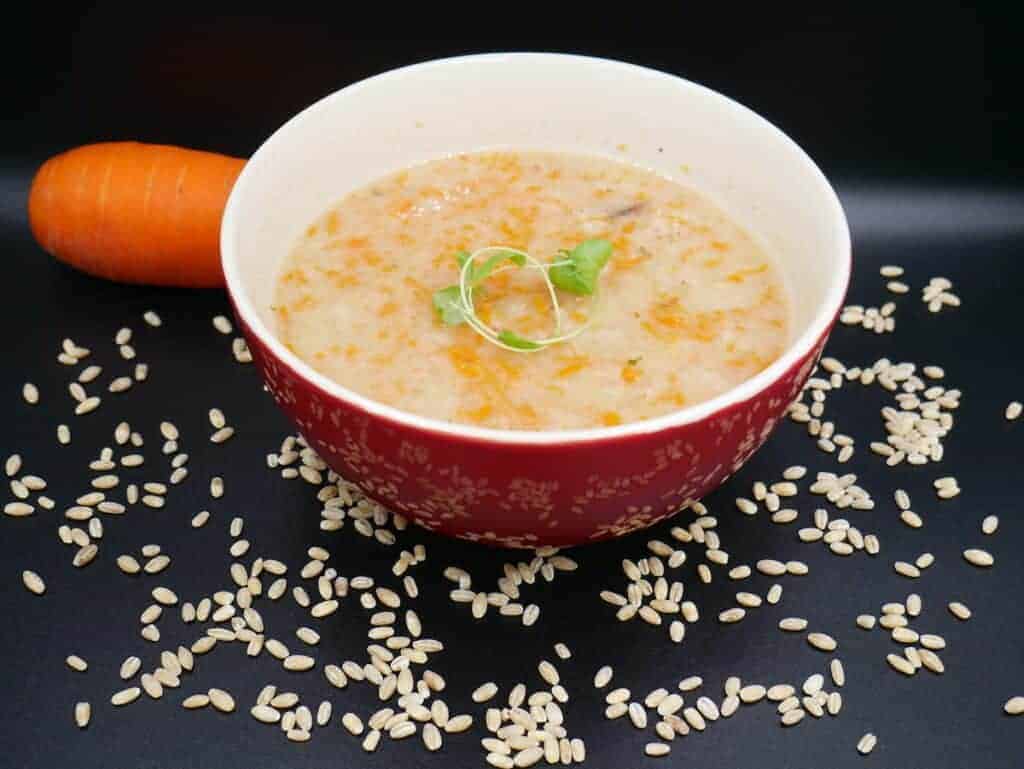
Krupnik is a traditional Polish soup featuring barley, potatoes, and carrots, cooked in a savory meat and vegetable broth. What makes it particularly appealing is its sticky texture, achieved through the slow cooking of barley. The name “krupnik” comes from the word “krupy,” which historically referred to coarse groats.
Krupnik is known for being a light and easily digestible dish. It’s a popular choice for serving to kids, those recovering from surgeries, or new moms. Of course, many Polish households also prepare and enjoy it as a regular lunch or dinner. It’s also the perfect simple and light soup to serve at a wedding before the heavier second courses come in!
If you want to make this comforting soup, you need to try my Polish Krupnik Soup recipe.
Polish Red Borscht Barszcz Czerwony
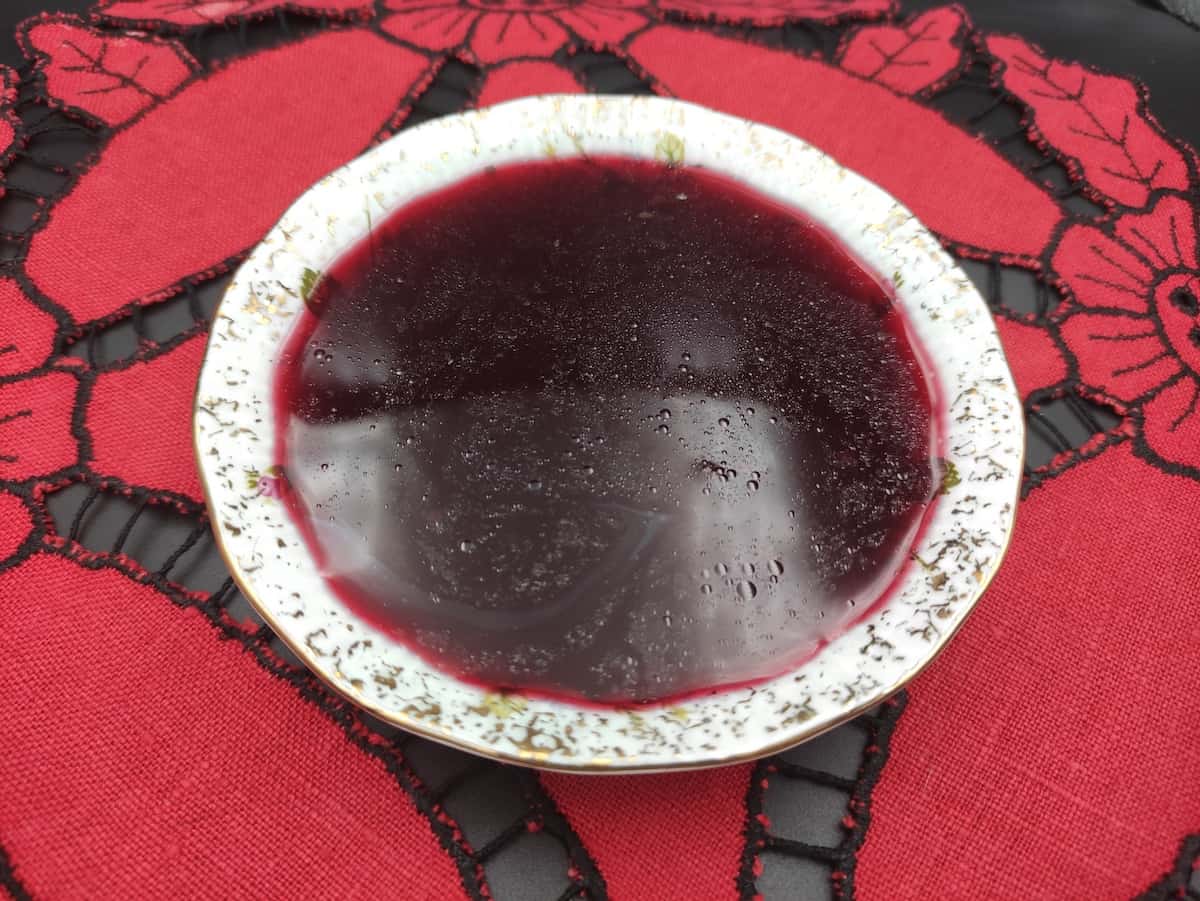
Now here’s a special Polish soup that’s not just for Christmas – it’s also a star at weddings!
The traditional Polish Christmas Borscht, also known as wigilijny barszcz czerwony, is a delicious blend of Polish flavours, a bit tangy, a bit sweet. It’s cooked on Zakwas Buraczany, a beetroot sourdough starter, creating a soup that can be enjoyed on its own or with uszka dumplings, or croquettes.
This soup is not only tasty but also nutritious, low-calorie, and packed with vitamins. It’s even known to be good for treating anemia. And guess what? At Polish weddings, it’s often served as the last dish to add that extra energy and round up all the meals, making sure the party goes on all night long!
If you’re up for it, here’s a straightforward recipe for Polish Christmas Borscht – easy to make and enjoy.
Main courses

Polish Roast Duck-Kaczka Faszerowana Mięsem
Kaczka Faszerowana Mięsem is a traditional Polish recipe featuring a roast duck filled with either apples or meat. Sometimes, cranberries are added to the stuffing. This rich and sophisticated duck dish used to be a favorite on the tables of royalty in Krakow, and it has become a symbol of Old Polish cuisine. These days, you might often see this Polish roast duck recipe in fancy restaurants across Poland. So, the next time you visit Poland, this dish is something you should order! Stuffed roast duck is also a popular choice for weddings, special events, and Christmas celebrations, making it a truly festive dish in Polish culinary tradition.
Despite its impressive appearance, making this Polish roast duck is not as hard as it might seem, and it will be something your guests will remember. Why don’t you check out my Polish duck recipe and give it a go!
Polish-Style Chicken Kiev Kotlet De Volaille
![]()
Originating in the 19th century from the kitchens of French chefs serving Russian royalty, this dish has left its mark on cuisines around the world, including Poland.
The traditional version of this popular kotlet features a stuffing of butter, garlic, and herbs, with some variations. So does, the Polish version but with slightly different fillings like cheese or Polish mushroom sauce. But the biggest difference is that in Poland, chicken is used instead of veal or pork, and the filling consists of ham and cheese.
If you tried and liked the traditional French Kiev, you will love the Polish version of it – kotlet de volaille!
Roladki Wieprzowe Polish Meat Rolls
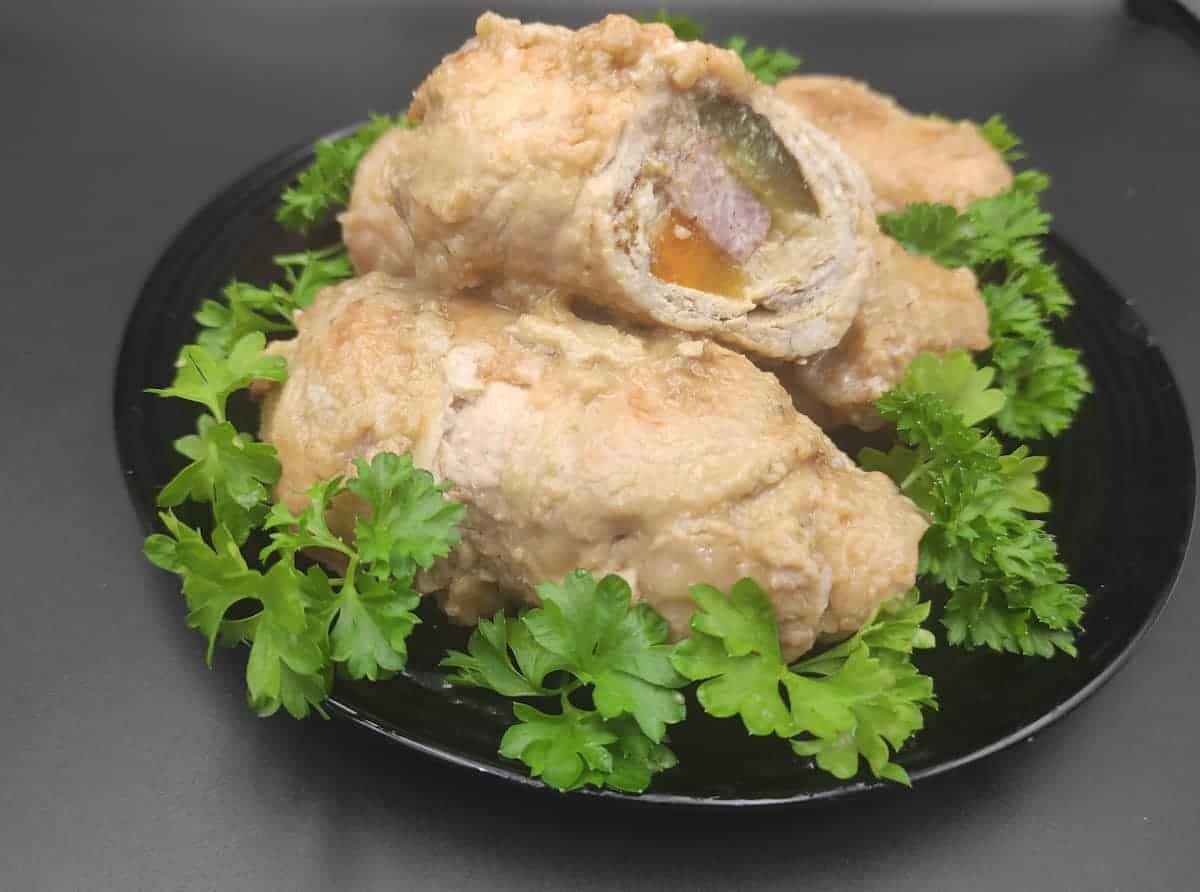
Roladki Wieprzowe, traditional Polish meat rolls or pork roulades made with pork ham or pork chops, mustard, and veggie sticks, are delightful dish often enjoyed at weddings. After being fried and then simmered, these rolls offer a delicious pairing with kluski śląskie, a type of Polish dumpling. Sometimes referred to as zrazy wieprzowe, they share similarities with roladki schabowe, which are stuffed with cheese, onions, mushrooms, potatoes, and eggs.
Try them out for yourself – your taste buds will thank you! Check out my recipe for these Polish Meat Rolls.
Traditional Polish Pork Cutlets Schabowy
![]()
No Polish feast is complete without schabowy, the iconic breaded and fried pork cutlet similar to Wiener schnitzel but always with pork. Schabowy, Polish-style pork chops, involves tenderizing pork, coating it with breadcrumbs, and frying until delightfully crispy. For home use, center-cut boneless pork chops work best.
In Poland, when you think of a traditional dinner, rosol and schabowy with mashed potatoes top the list. And these kinds of comfort dishes are very often a staple at Polish weddings! Typically served for Sunday dinner, rosol and kotlety schabowe bring families together after mass to enjoy a comforting meal.
Trust me, you won’t want to miss out on these classic Polish Cutlets – they’re a must-try!
Authentic Polish Golumpki
![]()
Stuffed cabbage rolls, known as gołąbki, are one of the most iconic Polish dishes, right up there with pierogi. While they’re easy to make, they do take some time, but the end result is worth it!
The term “gołąbki” in Polish translates to “small pigeons” or “doves.” Interestingly, the name has a historical connection – in the past, wealthy Poles enjoyed pigeon meat wrapped in cabbage leaves. The dish originated in Eastern Europe, making its way to Poland from Ukraine in the 19th century as a delicacy for the aristocrats, called ‘hołubci’ back then. In some regions of Poland, gołąbki without meat, often with buckwheat groats filling, are served for Christmas Eve dinner.
Here’s my mom’s authentic Polish gołąbki recipe that she uses every few weeks and here are the best toppings and side dishes for this meal.
These also can be cooked as a soup, so make sure to check out this Polish Stuffed Cabbage Soup recipe.
Authentic Polish Beef Goulash
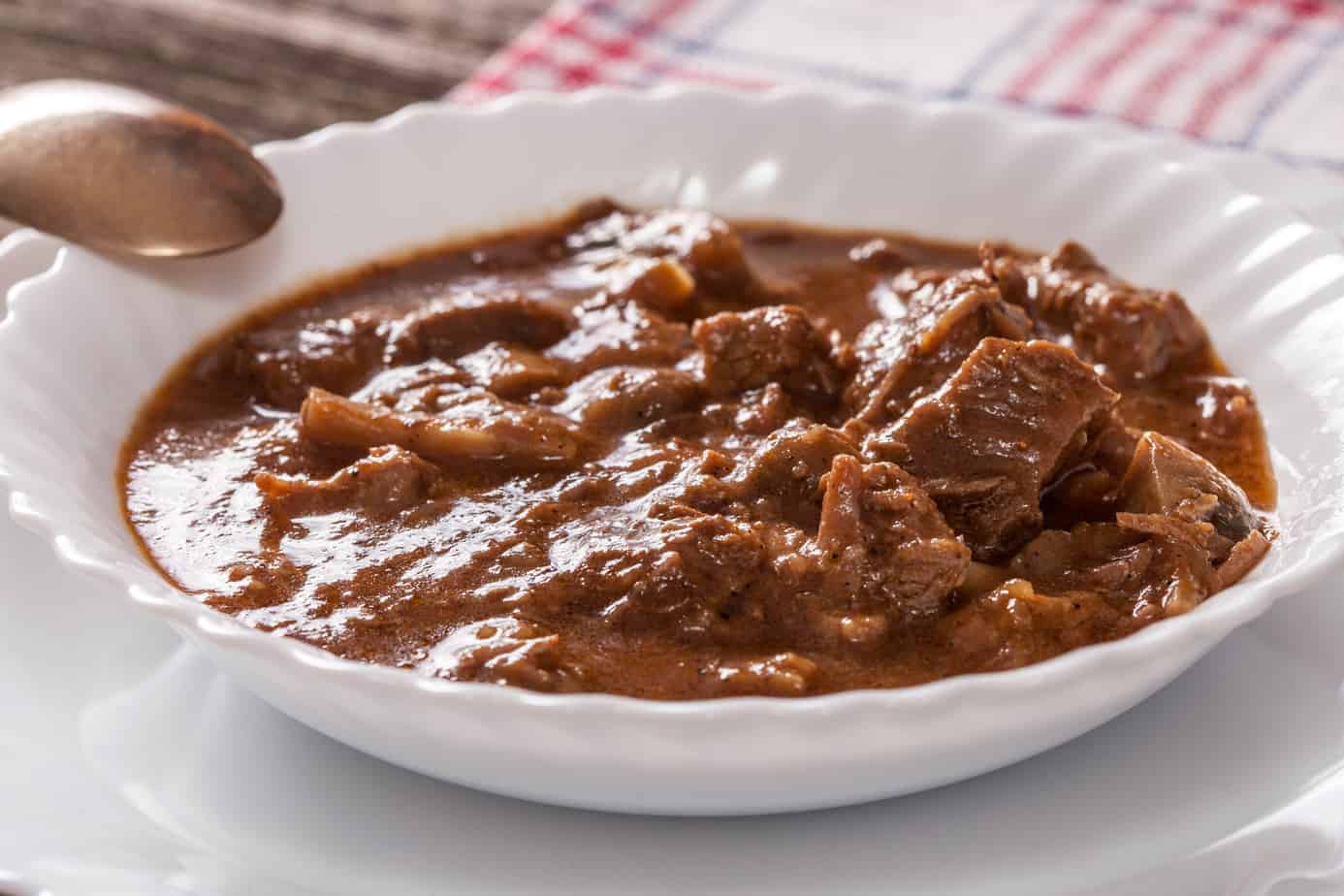
Goulash, originating in Hungary, is a traditional Polish meat stew or soup. Its name, gulyás, means herdsman in Hungarian, and the dish was initially known as gulyásleves, translating to “meat prepared by herdsman,” eventually becoming ‘goulash soup.’ Now enjoyed in various Central European countries, goulash can be made with pork, veal, lamb, or beef. Modern versions include potatoes, red peppers, veggies, or noodles, with paprika.
The Polish version, known as Gulasz, typically features pork, but beef, chicken, or turkey can also be used. It tends to be thicker than the original Hungarian version, offering a hearty and comforting dish. Pair it with bread, kopytka, or boiled potatoes and you have a perfect Polish satisfying meal!
Give this famous Polish Beef Goulash a shot – you won’t be disappointed.
Zimne Nogi Polish Jellied Pigs Feet
Jellied pigs’ feet, known as Zimne Nogi, is a traditional Polish dish typically enjoyed during the colder months. It’s often served with a squeeze of lemon juice or accompanied by horseradish. The concept behind this dish is to make the most of the entire pig when enjoying pork.
To make it, pig’s feet are cooked with root vegetables like carrots, celery, and parsley until they turn into a jelly-like substance. After chilling in the fridge, the jelly sets and is served cold. Some may find it a bit strange, as opinions are split – 50% of Poles love it, while the other 50% aren’t as keen.
Historically, Zimne Nogi was used to preserve meat due to the natural gelatin from pig’s feet. Even though we now have modern ways to preserve food, the natural gelatin and collagen in this dish have big health benefits. Cooking the pigs’ legs for a long time breaks down collagen in tendons, bones, cartilage, and marrow, forming gelatin, which is good for bone, joint, and teeth health.
If you want to try something different, go and take a look at my recipe for traditional Polish Jellied Pigs Feet!
Pork Chops Stuffed With Mushrooms

Polish pork chops is a perfect, easy-to-make meal for gatherings with friends or family, ready in just 35 minutes.
Known as schab zawijaniec nadziewany pieczarkami, these Polish pork chops are a delectable delight when filled with onions and mushrooms. Whether served with buraczki or sour cream, they add a delicious touch to any occasion, making them a cherished delicacy often featured at Polish weddings.
Looking for a tasty dinner idea? Try out my recipe for these mouthwatering Polish Stuffed Pork Chops!
Pierogi
No Polish celebration is complete without pierogi. These stuffed dumplings are quintessential Slavic comfort food and they make frequent appearances as main courses at weddings for good reason!
Pierogi Ruskie

Pierogi come in a wide range of flavors, with meat-filled options and the popular Pierogi Ruskie filled with farmer’s cheese, herbs, and potato. As important as the filling is the decoration. Polskie Pierogi are typically drizzled with oil and fried onions, but some recipes include pork scratching or bacon toppings for a stronger, saltier taste.
Making pierogi takes time; you’ll need at least a few hours to prepare everything. But trust me, it’s absolutely worthwhile. They are perhaps the most famous of Poland’s national dishes, enjoyed during special occasions like Christmas, Easter, weddings, name days, and birthdays.
If you’re unsure where to find farmer’s cheese, check out my homemade farmer’s cheese recipe (it’s really easy to make!).
My grandma, Babcia Marysia, makes the best pierogi in the world, and I’ve been enjoying them since I was a kid. The secret to her amazing pierogi? Take a look at this pierogi ruskie recipe!
Sauerkraut Pierogi
![]()
While the Polish Sauerkraut Pierogi recipe is enjoyed throughout the year, it gains special popularity during Christmas. For many families, dumplings with sauerkraut take centre stage on the Christmas Eve table, becoming a significant dish during the festive season.
It’s important to note that Polish pierogi, including sauerkraut pierogi, are popular dishes beyond Christmas. While I often include them in our Christmas Eve feast, making these pierogi is always a delightful treat. Sauerkraut pierogi are also a popular choice at weddings.
Here’s my Polish sauerkraut recipe !
Meat Pierogi
![]()
While vegetarian dumplings steal the show in Poland, the traditional Polish meat pierogi are a popular guest at Polish weddings and are equally worth trying. Children and adults alike love meat pierogi, and they rarely last long enough to be stored for later. You can enjoy them cooked, pan-fried, oven-baked, or even grilled.
While any meat can be used, beef stands out as the best choice. The classic meat pierogi filling features ground beef and veggies from rosol wołowy (beef broth). However, Polish housewives, depending on preferences, use different meats, including pork, chicken, turkey, duck, goose, and even lamb.
If you want to have a go at making these at home, make sure to follow this meat pierogi recipe for the best Polish Meat Pierogi.
Sides and Salads
At a traditional Polish wedding, the spotlight often shifts to the side plates, where simple ingredients like potatoes, beets, cabbage, and cucumbers end up becoming delicious dishes. Shaped by generations of tradition, these basic foods become essential in Polish cooking. The variety of salads, pickles, spreads, and snacks not only shows how versatile Polish food is but also how it can turn simple ingredients into something tasty.
Smalec – Mouthwatering Polish Lard Spread
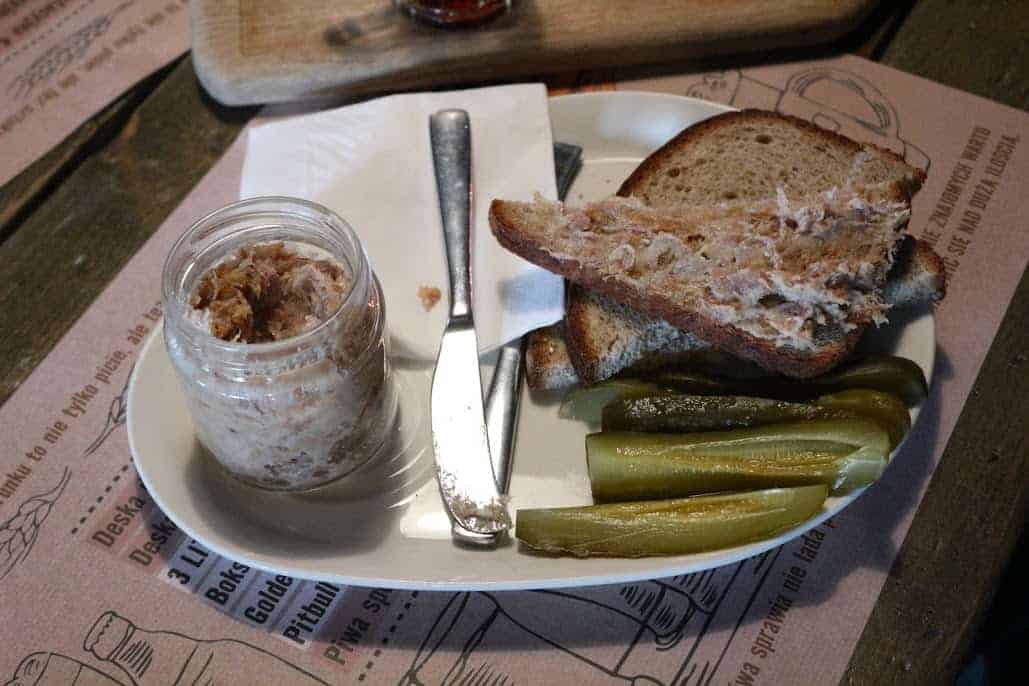
Ever tried spreading pork fat on bread and topping it with pickled cucumber? It might sound a bit unusual, but this traditional Polish food is surprisingly delicious! Smalec is best enjoyed with freshly baked sourdough bread with a crispy crust. It’s typically served with ogorek kiszony, a traditional Polish pickled cucumber.
When you visit a traditional Polish restaurant, you might get it as a free starter before your meal and naturally. It’s also a popular snack at Polish weddings and all sorts of gatherings.
Making lard spread is quick and easy, and you can keep it in the fridge for up to 2 weeks. Find out more about Polish Smalec and how to make it here.
Polish Dill Pickle
![]()
Polish dill pickles are known worldwide for their unique taste – not sweet like in the US, but delightfully sour with a strong flavor.
Aside from being delicious, these pickles are a very healthy superfood. They’re low in calories, high in fibre, and great for digestion. The good news is, that making homemade Polish pickled cucumbers is easy and budget-friendly.
For a traditional Polish vodka experience, take a shot followed by a bite of ogorek kiszony. It might be a quirky combo, but many people in Poland enjoy this party tradition, especially at weddings!
If you want to try this traditional Polish delicacy, check out my grandmother’s recipe for Polish Dill Pickles.
Kapusta Kiszona – Homemade Polish Sauerkraut

Kapusta kiszona is the traditional Polish version of sauerkraut, beloved by Poles worldwide. It’s also a national dish in Germany and popular across Central Europe. The fermentation process that produces lactic acid bacteria creates not only an amazing taste but also contributes to a healthy gut flora.
Such is the love for sauerkraut that festivals dedicated to it are held globally, including one in Phelps, the US, and another called Krautfest in Leinfelden-Echterdingen, Germany, attracting thousands of visitors. In Poland, the cabbage festival in Charsznica every September offers a chance to try this amazing side.
Making kapusta kiszona, the traditional Polish sauerkraut, is an easy and rewarding process that just requires time and patience to create a healthy meal. Just follow my simple recipe for Homemade Polish Sauerkraut and see for yourself!
Polish Croquette Krokiety
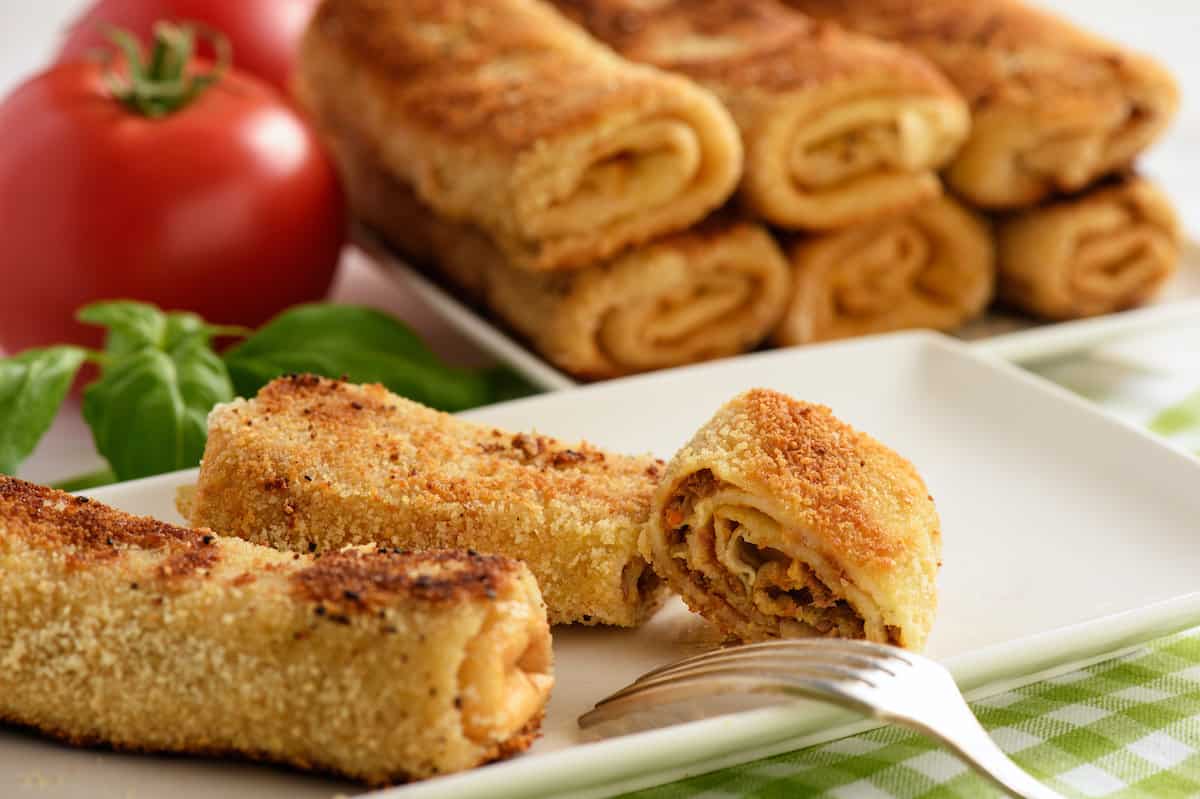
Delicious thin pancakes stuffed with kapusta kiszona, mushrooms, and onions, then fried to a crunchy perfection – that’s the essence of Polish croquettes, or krokiety! While croquettes exist in various cultures, the Polish krokiety recipe is a must-try.
Although making sauerkraut croquettes is easy, it does take time. Is it worth the effort? Absolutely! The Polish croquettes have a delightful crispiness on the outside and a soft, flavorful interior. You can enjoy them warm or cold – they won’t disappoint.
Want to try these for yourself? Follow my fool-proof recipe for these tasty Polish Croquettes.
Polish Herring Salad
![]()
One of my all-time favorite salads is Polish herring salad, known as “śledzie pod pierzynką,” which literally translates to herring under the duvet. The combination of mild eggs, potatoes, mayo, and distinctive herring and dill pickles makes this layered salad not only yummy but also visually appealing.
This salad is a breeze to make and is perfect for breakfast, supper, or a snack. If you’re hosting a Polish party (or wedding!), consider adding this herring salad to your menu – I’m confident your guests will love it!
Salatka Jarzynowa – Traditional Polish Salad

Have you ever tried the authentic Polish vegetable salad? No? You’re missing out! It’s a staple in every Polish home during celebrations like Christmas, birthdays, and weddings.
This salad is fast and easy to make, requiring just a few veggies, eggs, mayonnaise, and salt and pepper. The popularity of the Polish vegetable salad comes from the fact that the veggies used in the recipe are often leftover from making rosol (Polish chicken soup broth). Polish housewives discovered that by boiling some potatoes and eggs and adding ogorek kiszony (pickled cucumber), peas, and mayonnaise, they could create a delicious salad.
If you would like to make this popular Polish salad at home, make sure to follow my recipe for Salatka Jarzynowa.
Polish Coleslaw
![]()
Surowka z kapusty, or Polish coleslaw, is a very popular and tasty salad in Poland known for its refreshing taste and crunchy texture. This salad typically features shredded cabbage as its main ingredient. Alongside cabbage, other vegetables such as carrots may be added to enhance both flavor and color. The dressing for Polish coleslaw is made with mayonnaise, salt and pepper. It’s as simple as that!
What makes Surowka z kapusty a popular choice is its versatility and ability to complement various Polish dishes. It’s often served as a side dish during family celebrations, picnics, or as a topping for sandwiches.
Follow my quick and simple Polish Coleslaw recipe to make this amazing salad at home!
Traditional Polish Village Wedding Dishes
A wedding in a traditional Polish village features food that reflects the rural setting. Unlike fancier city receptions, the menu showcases hearty, rustic fare made from ingredients readily available on the farm or in the countryside. Some Polish wedding foods may take hours or days to prepare the traditional way. Here are the three most popular dishes at a traditional Polish village wedding!
Authentic Polish Bigos
![]()
This Polish bigos stew is a delicious and satisfying dish enjoyed not only in Poland but around the world!
Traditionally, Polish bigos include game meat like venison or wild boar, but nowadays, pork and kielbasa are commonly used. Bigos is often served at Christmas and weddings, especially during the winter months. The dish originated from a time when ingredients like sauerkraut, onions, and meat were readily available in winter. Without refrigeration, people made the most of what they had.
Cooked slowly for days, bigos is often prepared in large quantities, perfect for sharing among family members. The greasy and filling nature of bigos makes it a comforting and warming choice after a chilly day.
So, if you’re looking for a satisfying, warming dish, give my recipe for Polish bigos a try!
Polish Sausage
![]()
Kielbasa, a famous Polish sausage loved worldwide, is not only tasty and filling but also made from high-quality meat.
Traditional Polish kielbasa is typically made from pork meat. While you can find variations made from poultry, fish, or tofu (vegetarian kielbasa), they’re not as popular. In Poland, many still prefer making kielbasa the traditional way, especially in rural areas where smokehouses are common even in modern households.
Discover how to cook flavorful kielbasa with this recipe!
Polish Sourdough Multigrain Bread
![]()
Polish multigrain sourdough bread is soft and rustic, perfect to pair with soup, meat dishes, or just buttered toast.
Sourdough bread holds a special place in Polish homes, symbolizing not just a meal but Christianity, God, nobleness, dignity, hard work, and home. Generations have made the cross sign before cutting the bread, kissed it as it fell, and cherished every crumb. In Poland, a married couple is welcomed with bread and salt after their wedding.
What makes sourdough bread so great? Besides its delicious taste, it stays fresh for nearly two weeks, making it a perfect addition to meals like żurek and other soups.
Next time you have guests over, wow them with fresh, from-scratch bread that you can easily make at home using my recipe for Polish Sourdough Multigrain Bread.
Desserts
At Polish weddings, the sweet ending is the best part! They serve trays of traditional desserts that have been loved for generations. While Polish food is famous for being hearty, the cookies, cakes, and pastries at weddings are just as nice and deserve a special mention.
Beza Meringues
![]()
Beza is a tasty Polish dessert made by whipping egg whites with sugar until it forms a delightful treat that you can easily finish in one bite.
There are different types of meringues. The one we often call the ‘basic meringue’ is the French meringue, possibly invented in the 17th or 18th century. It involves whipping sugar into egg whites, and our Polish beza meringues are quite similar—just a different name!
There are two other popular types: Swiss meringue, made by double boiling, and Italian meringue, made with sugar syrup. But when it comes to making beza or homemade Polish meringues, it’s a quick process. A bit of whipping and some time in the fridge or freezer, and you’ve got the perfect Polish dessert!
Next time you have guests coming over, make sure to serve some delicious Polish Beza and they won’t be disappointed.
Andrut Polish Wafer Cake
![]()
Andrut wafers, originally from Kalisz, are a delightful Polish dessert with sweet layers of kajmak between light and crisp wafers. You can easily make this popular wafer cake at home in just 10 minutes, using readily available ingredients from any store or online site.
Andrut, also known as andruty kaliskie, is a traditional semi-sweet Polish treat made by layering wafers with kajmak. The roots of andruts trace back to Kalisz in the 18th century, where they were often served as a dessert. On December 9, 2005, andruts earned a spot on the List of Traditional Products by the Ministry of Agriculture and Rural Development.
What’s more, on April 22, 2009, the Kalisz wafers used in making andruts received recognition in the EU register as a Protected Geographical Indication, ensuring they can only be produced in Kalisz.
To make these treats at home, simply follow my recipe for Polish Andrut Cake and see what the fuss is about for yourself!
Polish Cream Horns Rurki Z Kremem

Rurki z kremem, or Polish cream horns, are delightful conical pastries perfect for a sweet snack or dessert. You can make your own rurki using this traditional Polish cream horns recipe!
These cream horns consist of pastry dough laminated onto a roll shape, with openings at both ends. They are then filled with a rich cream filling or custard, and the dough can be either flaky or puff pastry.
Polish Wedding Drinks
Traditional Polish Kompot
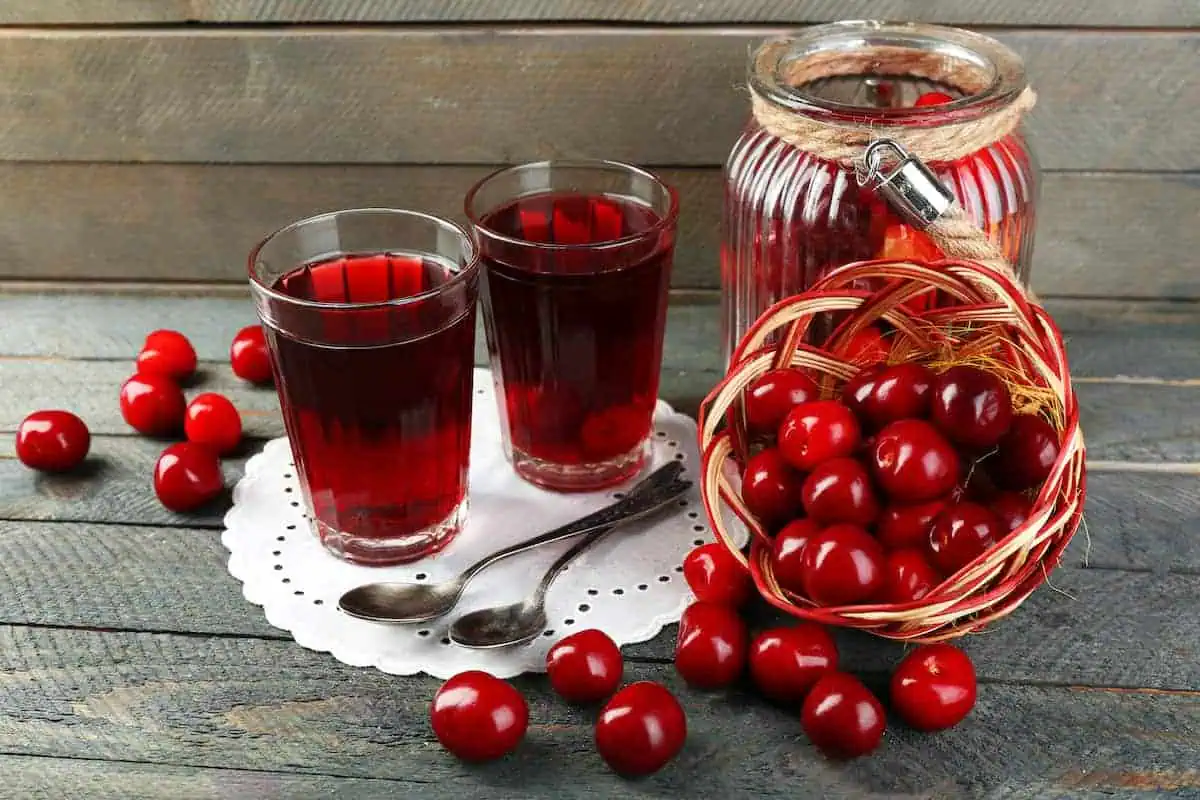
Kompot is the go-to non-alcoholic drink in Poland, and it’s a staple at every Polish wedding. Making this fruity beverage is incredibly easy – you just need three ingredients. It’s the perfect choice for a refreshing homemade fruit drink!
Unlike fermented drinks, kompot is entirely alcohol-free, making it a family-friendly beverage. Kids love it and since it’s super healthy, they can enjoy it without limits. You can serve it hot or cold, and it remains a popular choice throughout the year.
Follow my Polish Kompot recipe and see how easy and quick it is to make at home!
Vodka
![]()
You have to remember that no wedding party is complete without vodka. Vodka is extremely meaningful in Polish culture, especially at big celebrations. At a Polish wedding, this alcohol can be found on each table.
Polish vodka is made from grains like rye, wheat, or potatoes, resulting in a clear, tasty liquor that can be 35% to 50% alcohol.
When guests show up, the parents of the bride and groom welcome them with chilled vodka shots to show hospitality and kick off the festivities. Following the ceremonial greeting, the couple traditionally has their first toast. Typically, the father of the bride or groom presents the newlyweds with two glasses – one with vodka, and one with water. The glasses are first offered to the bride, who must make her choice without knowing which contains vodka. Tradition says that whoever ends up with the vodka glass will be the dominant partner in the relationship. After their drink the couple throw their glasses; if they break, it signifies good luck.
Throughout the night, guests frequently raise toasts of “Na zdrowie!” meaning “To your health!” as they merrily clink glasses of smooth Polish vodka. The vodka flows freely over the course of the wedding to celebrate the bonding of the two families.
If you are not fond of taking vodka shots all night, you had better have an excellent excuse! Because at a Plish wedding very often you will be talked into drinking for the entire night.
And while we’re at it, I must add that Polish vodka comes in many flavors. Most of these you can make at home so you have to give this Polish Mint Vodka recipe a go!
If you want to read more about Polish vodka and the best kinds, go to my post on the Best Polish Vodka – Top Brands, Comparison Charts And Facts.
Want to learn more about the Polish wedding? Watch the video from my wedding below!

